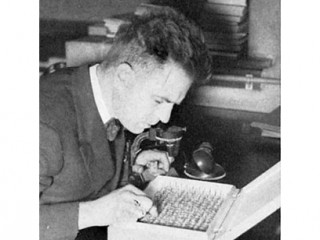
Alfred C. Kinsey biography
Date of birth : 1894-06-23
Date of death : 1956-08-25
Birthplace : Hoboken, New Jersey
Nationality : Américaine-Française
Category : Famous Figures
Last modified : 2010-11-21
Credited as : Biologist , and zoologist,
The American zoologist Alfred C. Kinsey was known chiefly for his pioneering case studies in the area of human sexual behavior.
Alfred C. Kinsey was born in Hoboken, New Jersey, the son of an engineering professor, on June 23, 1894. He received his doctorate in 1920 from Harvard University, where he had been awarded the Sheldon travelling fellowship. He held teaching appointments in both botany and zoology at Harvard before becoming assistant professor of zoology at Indiana University. By 1929 he was made a full professor there.
Kinsey won his early reputation as an entomologist with research on the life of the gall wasp. Studying minutely 28 factors on a large proportion of the more than four million specimens he examined, Kinsey provided research which added much to knowledge of genetics and evolution. He might now be famed only among biologists had he not in the 1930s joined 11 other teachers in giving a marriage course.
Students asked him about sex, and he quickly learned that there were few scientific answers to their questions. Soon he resolved to try to apply accepted methods of scientific research to the universal problem of sexual behavior, and he courageously set himself a long range task, in the face of tradition and taboos. His results made the Indiana University campus a world center for research in human sexual behavior.
Kinsey began his sex studies in 1938, embarking on a well-planned, long-range program designed as "a progress report from a case history study on human sex behavior." In the project outlined, nine volumes would be presented requiring at least 30 years of work by many people. However, by the time of his death in 1956 Kinsey had completed only two volumes.
Initially, Kinsey had the help of one graduate student, whom he paid $900 per year out of his own faculty salary. The first outside financial assistance he received for sex research was $1,600 from the National Research Council in 1941. By 1942 scientists of the Medical Division of the Rockefeller Foundation, after a thorough investigation of Kinsey's work, recommended that the foundation give its support. This it did with grants of as much as $100,000 a year allocated through the National Research Council. By 1954, however, the Rockefeller Foundation cancelled its contribution.
Before publication of his first book, Sexual Behavior in the Human Male, in 1947, Kinsey was still hardly known outside a narrow circle of biologists. He incorporated his research under the title of Institute for Sex Research, Inc., and all royalties for his first book and the second, Sexual Behavior in the Human Female, were used to finance further research.
The first book appeared in 1948 and was based on case studies of some 5,300 individuals. Although Kinsey's intention was to record facts as they had been found and to leave it to others to place interpretation on them, public interest in the book was aroused by the statistical analyses which showed a correlation between an individual's sex habits and the educational and occupational groups to which he belonged. Especially controversial was one conclusion which stated that actual sex practices deviated significantly from the accepted norms established by laws and conventions of society. Anthropologist Margaret Mead found the material "extraordinarily destructive of interpsychic and interpersonal relationships." Nonetheless, the Kinsey Report, as the book came to be called, sold 300,000 copies and became an instant bestseller.
The controversy over Kinsey's earlier findings was still in full swing in 1953 when the second book, which was based on interviews with 5,940 women, appeared. It likewise became a bestseller, with 227,000 copies sold. Alan Gregg of the Rockefeller Foundation wrote:
As long as sex is dealt with in the current confusion of ignorance and sophistication, denial and indulgence, suppression and stimulation, punishment and exploitation, secrecy and display, it will be associated with a duplicity and indecency that lead neither to intellectual honesty nor human dignity. Kinsey's studies are sincere, objective, and determined explorations of a field manifestly important to education, medicine, government, and the integrity of human conduct generally. They have demanded from Kinsey and his colleagues very unusual tenacity of purpose, tolerance, analytical competence, social skills and real courage.
Later scholarship pointed to Kinsey's pioneering case studies as also important for bringing controversial subject matter out in the open for informed discourse. The Kinsey Institute for Research in Sex, Gender and Reproduction at Indiana University provided a living monument to his pioneering work.
There are two biographical studies of Kinsey: Cornelia V. Christenson's Kinsey, A Biography (1971) and Wardell Pomeroy's Dr. Kinsey and the Institute for Sex Research (1972). A chapter on his pioneering work is in Paul A. Robinson's The Modernization of Sex (1976). Detailed critiques of his case study approach to human sexual behavior appear in William Cochran, Statistical Problems of the Kinsey Report on Sexual Behavior in the Human Male (1954); Albert Deutsch, Sex Habits in American Men (1948); Morris Ernst, American Sexual Behavior and the Kinsey Report (1948); and Jerome Himelhoch, Sexual Behavior in American Society (1955).
















